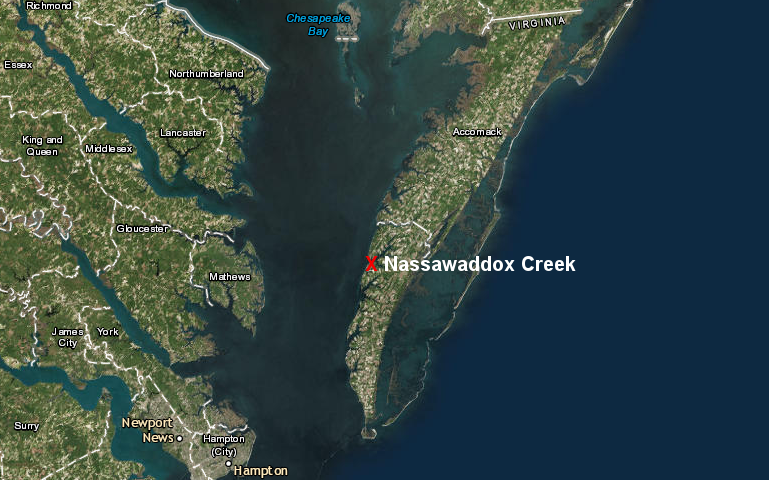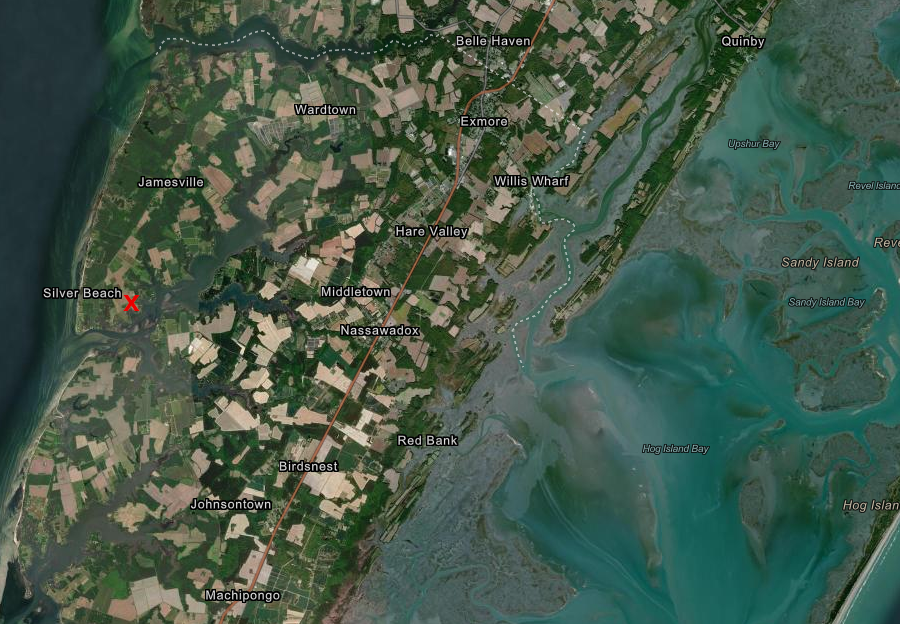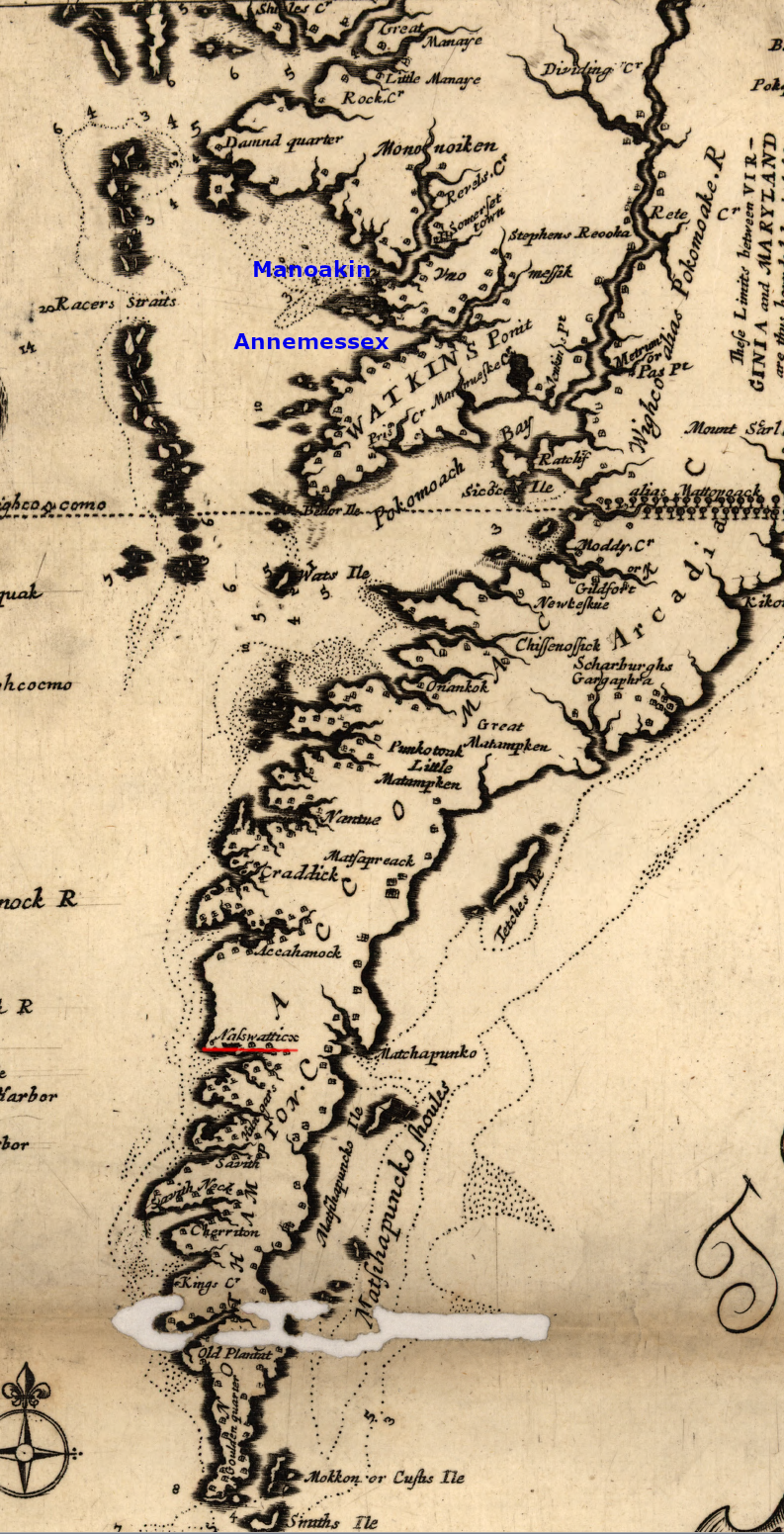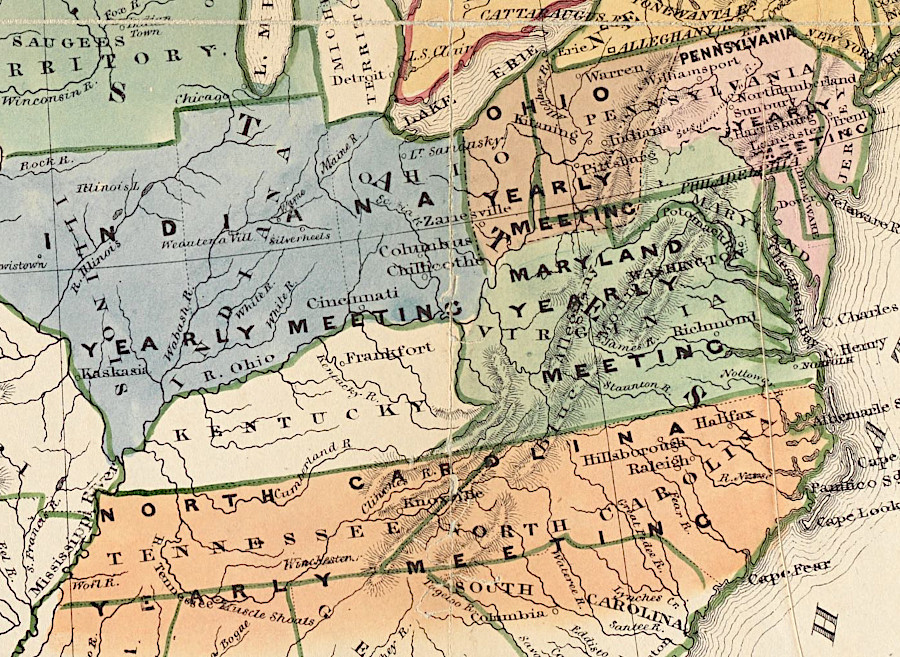
ships claiming to be sailing up the Chesapeake Bay to Maryland could land Quakers at Nassawadox Creek on the Eastern Shore
Source: ESRI, ArcGIS Online
The Quaker meeting at Somerton (near Suffolk) claims to be "the oldest continuous congregation in Virginia."1
The congregation first started worshipping together in 1672, after George Fox made his one trip to Virginia to preach his version of true faith. Fox was not the first missionary from the Religious Society of Friends to cross the Atlantic Ocean. The first two women who visited the Massachusetts Bay Colony in 1656 were accused of witchcraft by the Puritan leaders and forced to leave after two months. Others who arrived later were jailed, fined, and even executed.2
The Quakers were in violation of the Act of Uniformity passed by Parliament in 1662, and were not welcomed by the Anglican leaders in the Virginia colony. Because they lacked a structured hierarchy which could provide assurances that the religious beliefs would not challenge the authority of the King or Queen, Quakers were not viewed with the same tolerance as Presbyterians or Anglicans who evolved into Methodists. Without a comittment to obey formal leadership, Quakers were viewed as religious anarchists.
By locating at the edge of the Dismal Swamp, Virginia Quakers were subject to less harassment in the 1600's.
The Quaker beliefs in equality between races and sexes were non-traditional, and the Somerton group experienced local hostility when it taught freed slaves after the Civil War ended. The school and meeting house was burned in 1866. The current Somerton Friends Meeting House on Quaker Drive, east of Quaker Swamp, was constructed in 1867, and a historical marker was installed next to it in 2016.3
In Virginia, the counties that exported the most tobacco developed the strongest economic and cultural ties to England in the 1600's, and had the most traditional social structure tied to the Anglican church. The areas in Virginia with poor soil for growing tobacco, particularly south of the James River (at Lower Norfolk, Nansemond, and Isle of Wight) and the Eastern Shore developed their trade with other colonies in North America and the Caribbean islands.
Commercial links reinforced religious links. The counties with a higher percentage of intercolonial trade interacted with more diverse cultures, and had a higher percentage of resident Quakers and Puritans. The first Quaker preachers came to Virginia in 1650's, mostly from England via Barbados.
Quakers on Virginia's Eastern Shore were concentrated in 1657 at the mouth of Nassawadox Creek. What may have been the first Friends meetinghouse in America was built near there, opposite Warehouse Creek according to one report. Another suggests it was a "ten foot house" used for meetings until it was required for grain storage. Otherwise, private homes were used for meetings at Nassawadox and elsewhere on the Eastern Shore until 1679.
The first documented Quaker missionary was William Robinson, arrested on the Eastern Shore in 1658. He as accused of denying the humanity of Christ and being "a seducer of people to faction." The Puritans had seized control of the colonial government, and Quaker preachers were judged to be felonies.4

ships claiming to be sailing up the Chesapeake Bay to Maryland could land Quakers at Nassawadox Creek on the Eastern Shore
Source: ESRI, ArcGIS Online

the exact location of the Quaker meeting house on Nassawadox Creek is unknown, but could have been opposite Warehouse Creek
Source: ESRI, ArcGIS Online
Puritan and then Anglican officials in colony pushed back against Quakers, ordering preachers to leave and threatening to fine ship captains who brought Quakers to Virginia. Quakers threatened the traditional hierarchy of the gentry by claiming everyone had a universal inner light. Because Quakers rejected the need for a paid minister or a parish vestry, growth of that religion posed an existential threat to the people paid to serve as Anglican ministers and vestry in Virginia.
Quakers in Virginia were persecuted more than Puritans. One scholar summarized the challenge that independent-thinking Quakers presented to the stratified society in Virginia:5
In 1660, the Royalist governor William Berkeley was restored to that office, as Charles II gained he throne in London. That year General Assembly passed the first law specifically intended to discriminate against the Quakers, described as:6
Additional laws passed in 1662 and 1663 required baptizing children according to Anglican church practices, making everyone over 16 to attend Anglican church services, and imposing a fine of 200 pounds of tobacco on anyone attending a Quaker service. One of the Quaker leaders, George Wilson, was imprisoned in Jamestown and died there as a result of rough treatment, including being chained to a post while in jail. He is the only documented Quaker martyr in Virginia in the 1660's. William Robinson had moved to Massachusetts, and in 1659 had been executed there with three other Quakers for returning from banishment and continuing to preach doctrines unacceptable to the Puritan leaders in Boston.
There was some sympathy for the Quakers in the House of Burgesses, and John Porter was expelled from the colonial legislature for being "loving to the Quakers."7
Maryland, a colony led by Catholic that experienced their own discrimination in England, was more tolerant of different religious groups. Ships carrying Quakers to Virginia pretended to be sailing to Maryland, before surreptitiously landing them on the Northern Neck or Eastern Shore.
Maryland governor Charles Calvert sought to increase the number of colonists on the Eastern Shore who would be loyal to his government. The Catholic leader was contending with the Nanticokes for control of the area, and recognized that Virginia claimed the territory. The Anglican officials might not send militia into Maryland, if needed for military defense.
Gov. Calvert offered new settlers 50 acres plus the right to practice their religion freely. That attracted Quakers, who moved north across the colonial border from Virginia's Eastern Shore to the area around the Annemessex and Manoakin rivers.

Gov. Calvert recruited Quakers to moved from Virginia to Annemessex-Manoakin in Maryland in 1661, offering land and religious freedom
Source: Library of Congress, Virginia and Maryland as it is planted and inhabited this present year 1670 (by Augustine Herrman, 1673)
Most Quakers on the Eastern Shore moved across the Pocomoke River into Maryland by 1662, escaping harassment by Col. Edmund Scarborough. On October 12, 1663, however, Scarborough led 40 horsemen across the disputed colonial border and raided Quaker settlements.
In response, Maryland governor Charles Calvert traveled to Jamestown to complain to Virginia Governor William Berkeley. Berkeley soothed Calvert by promising to resolve the boundary dispute on the Eastern Shore, and Virginia officials stopped arresting Quakers on the Eastern Shore and trying to suppress the "schismaticks" by 1664. In 1668, the Calvert-Scarborough line was surveyed to define to Virginia-Maryland border from the Pocomoke River to Chincoteague Bay.
In 1673, George Fox visited the Quakers at Annemessex, while his companions crossed border to talk to those Quakers still remaining in Virginia.
Quaker missionary John Boweter visited the Eastern Shore in 1678. A year later, Quakers purchased land to build the Muddy Creek (Guilford) meetinghouse neat Bloxom. Another was built 25 miles away at Nassawadox. The two were treated organizationally as the "Lower Monthly Meeting" while the three meeting houses just north of the Virginia-Maryland boundary were called the Somerset Monthly Meeting. In the 1600's all the Eastern Shore meeting houses associated with Maryland Quakers, separate from other Virginia groups.
Despite allowing meeting houses to be constructed, Virginia officials continued to refuse accept Quaker marriages as legal. Couples who chose to wed in the presence of God but without the services of an Anglican minister were being accused of fornication as late as 1690.
After Pennsylvania was founded 1682, Virginia governors were nervous that Quakers on the northern border would not fight the French occupying the St Lawrence River valley or the Iroquois/Susquehannock that raided south. When Francis Nicholson served as lieutenant governor in 1690-1692, he required local officials to interrogate traveling Quakers and requested William III to set up a colonial postal system so information could move faster between governments.
Bishop of London Henry Compton (who was responsible for the church in Virginia) required new ministers get certificates from him before going to Virginia, starting in 1680.
Two years after the Glorious Revolution in England in 1688 and the replacement of Catholic James II with Protestants William and Mary, Parliament passed the Act of Toleration. Bishop Compton also appointed an agent ("commissary") to oversee activities in Virginia. Commissary James Blair got approval for the College of William and Mary because religious and political leaders wanted to ensure conformity/control by training ministers, so they would reinforce traditional Anglican beliefs and the traditional social hierarchy in Virginia despite the 1688 Toleration Act.
The Virginia General Assembly did not formally acknowledge toleration until 1705, allowing allowed Quakers to affirm rather than swear oaths in court. That occurred one year after the high-profile daughter of Col. Edmund Scarborough had refused to take an oath because she had become a Quaker. The ability to "affirm" allowed Quakers to serve as county offices, including as a justice on the county court.
Wider acceptance led to stresses within the Quaker community, Children were more inclined to marry outside of it, and attendance at the meetinghouse declined in the early 1700's. Envoys from the Somerset Monthly Meeting to the Lower Monthly Meeting in 1721 discovered only a few members attending irregular meetings. The last reports from the Muddy Creek and Nassawadox meetings were in 1729. Services at Muddy Creek ended first, then Nassawadox became defunct. The last formal record of a Quaker event on the Eastern Shore of colonial Virginia was a 1753 marriage; by then, even the Somerset Monthly Meeting was no longer active. Today, there are no meeting houses in Accomack or Northampton counties.8
The history of Quakerism in Virginia, other than on the Eastern Shore, is more lasting.
South of the James River the traveling ministers of the Quakers, known as Public Friends, followed Indian trading paths inland. The best Anglican ministers sought parishes near Jamestown and in the tobacco-growing areas where glebe lands would generate more income, and were less inclined to proselytize in the backcountry where Quakers were accepted.9
A Virginia Yearly Meeting started in 1702. It continued to 1844. Today, Virginia meetings are affiliated with the Baltimore Yearly Meeting, except Abingdon and Fancy Gap are connected to the Piedmont Friends Fellowship & Yearly Meeting.10

in 1844, Quakers in Virginia participated in the Maryland Yearly Meeting
Source: Boston Public Library, Norman B. Leventhal Map Center, A map of North America, denoting the boundaries of the yearly meetings of Friends and the locations of the various Indian tribes (1844)